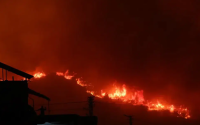Daniel CresseyNature
Tiny particles of pollution may be causing as much warming as greenhouse gases over southern Asia. The clouds of aerosol particles are contributing to the potentially devastating melting of Himalayan glaciers, say researchers.Using data from unmanned aircraft flying through 'brown clouds' of aerosol pollution over the Indian Ocean, US researchers found the zone of the atmosphere containing the clouds is warming by 0.25 ºC, compared with 0.10 ºC per decade at ground level.The Himalayas and the clouds occupy the same zone of the atmosphere, so the extra warming could be accelerating glacial retreat."This is a big topic of conversation over there [in India]. Much of the water supply of north and central India is from major rivers fed by glaciers in the Himalayas," says study author David Winker of the NASA Langley Research Center in Virginia.Temperatures risingOn a global scale, clouds of aerosols from biomass burning and fossil fuel consumption cool the atmosphere by reflecting sunlight back into space. But the particles also absorb solar radiation, and it has been suspected they could warm certain levels of the atmosphere. "It is becoming more obvious that the role of aerosols is not as simple as we once thought," says Piers Forster, an Earth scientist at the University of Leeds, UK. "They don't just provide cooling, they're actually giving far more complicated and regional changes."Direct measurements of the effects of aerosols are difficult, and satellite measurements have been available for only five years. To investigate the question, in March 2006 Winker and his colleagues flew 18 unmanned aircraft missions from the small island of Hanimaadhoo in the Maldives. They report their results in Nature1.Three aircraft flew over the Indian Ocean simultaneously at between 0.5 and 3 kilometres above sea level. In the second half of the month — when there was heavy pollution arriving from southern Asia — the heating rate of this band of the atmosphere more than doubled.Occurring annually, Asian brown clouds can cover parts of southern Asia, as well as the Arabian Sea and the Bay of Bengal, from November to April2.Melting iceUsing simulations of atmospheric heating from 1950 to the present, the team determined that brown clouds plus greenhouse gases contributed 0.15 ºC to the warming trend of 0.25 ºC per decade in this part of the atmosphere. "The data show the brown-cloud heating is as much as 50% of the background heating of the atmosphere," says the study's leader, climatologist Veerabhadran Ramanathan of the Scripps Institution of Oceanography in San Diego, California.The simulation results are similar to observations, he adds. "Glaciologists have shown the Himalayan region has been warming by a quarter of a degree per decade. That is almost twice the warming trend of the global warming.""[Aerosols] are very important on the regional scale," says meteorologist Eleanor Highwood of the University of Reading. Using these aircraft to take direct measurements is a step forward, she adds: "I'd love one."






